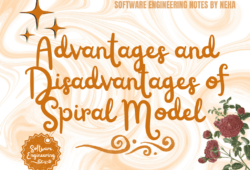Advantages and Disadvantages of Iterative Waterfall Model
 Posted On
Posted On
Posted By nehakarwal
Advantages and Disadvantages of Iterative Waterfall Model:
1. Advantages of Iterative Waterfall Model:
- It allows feedback to proceeding stages and hence is not very rigid.
- Some working functionality can be developed and early in the software development life cycle (SDLC).
- It is best suited for agile organisations.
- It can be used for project in which requirement are not well understood.
- Easy error correction.
- It is more cost effective to change the scope or requirements in Iterative model.
- Testing and debugging during smaller iteration is easy.
- Risks are identified and resolved during iteration and each iteration is an easily managed.
- We can detect the defects, faults, and risks at an early stage.
- Supports user feedback.
- More time is utilized for software development.
- Less time is utilized for documentation.
- Parallel development can be planned.
- This model is simple and easy to understand and use.
2. Disadvantages of Iterative Waterfall Model:
- It is harder to manage this model.
- No clear milestone in the development process.
- No stage is really finished.
- More resources may be required.
- Although cost of change is lesser, but it is not very suitable for changing requirements.
- More management attention is required.
- It is not suitable for smaller projects.
- Project progress is highly dependent upon the risk analysis phase.
- Requirements changes, again and again, can cause over budget and over time.
- Design can be changed again and again due to non-perfect requirements.
- High amounts of risk and uncertainty.
- Not a good model for complex and object-oriented projects.


